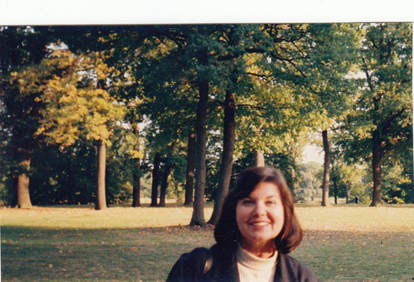 Sherrill in Potsdam, Germany, 1992
Sherrill in Potsdam, Germany, 1992 Her excitement at the prospect was catching, so now I was looking forward to it, as well.
A four-hour boat trip along the Moselle took us from historic Cochem in the wine-producing Moselle Valley to the city of Koblenz, where the Moselle met the bigger Rhine at the Deutsches Eck, or "German Corner," a massive concrete triangle that poked its snout between the two rivers as their currents collided. We could see the two rivers battling it out, stirring up wild foamy patterns in the water. An ugly statue looked over the confluence from our side and a massive, ugly fortress stood on the cliff opposite, but the combative meeting of the rivers between them was beautiful.
"Now, I understand why you wanted to see this," I told Sherrill.
She just smiled in reply.
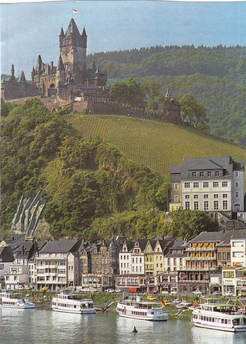 Cochem & Reconstructed Castle
Cochem & Reconstructed Castle Dusseldorf, like so much of Germany, also suffered from massive bombing during the War, so there wasn't much left of its old city, either, although the new city had a stylish energy—especially the Konigsallee, a shopping boulevard shaded by chestnut trees. We window-shopped at the high-end clothing stores, dropped in at three museums, and ate at a sidewalk cafe opposite the canal running down the center of the street. Gold leaves blew around our feet, I remember, but the air was still warm. It all was very pleasant, but we could have been anywhere in the world. The city seemed to have turned its back on both the Rhine and the past.
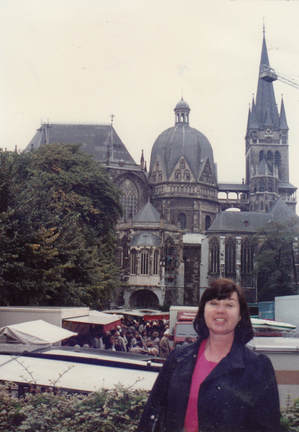 Sherrill, Aachen Cathedral & Street Market
Sherrill, Aachen Cathedral & Street Market Sherrill always enjoyed discovering another reliquary displaying another holy body part, but Aachen had the biggest cache since the village of Conques on the way to Santiago de Campostela. She knew all about Charlemagne and his passion for relics. While his church was being built, he sent messengers to Jerusalem and Constantinople to buy relics for him. The "Four Great Aachen Relics" in his collection reputedly were: the garment worn by Mary on the night of Christ's birth, the swaddling clothes of the Infant Jesus, the blood-stained loincloth of Jesus on the cross, and the cloth used at the beheading of John the Baptist.
"They're all here," she told me. "In that."
She pointed to a gold, jewel-encrusted statuette of Mary and baby Jesus.
"But we can't see them."
She smiled. "You have to take it on faith, dear, that they're inside."
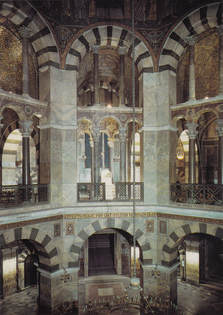 Charlemagne's Throne, Aachen Cathedral
Charlemagne's Throne, Aachen Cathedral I was impressed that Charlemagne's chapel, with his tomb and white marble throne, dated back to the year 800. When we were there in 1992, damage from World War Two still was being repaired. As if to underline the passage of time, across the street from the cathedral stood a shiny new, very popular, McDonald's restaurant—a small version of its golden arches discreetly above the doors.
"A lot valuable real estate is going to be available for development, now," I told Sherrill.
"And who is going to develop it?"
"That's the question, isn't it?"
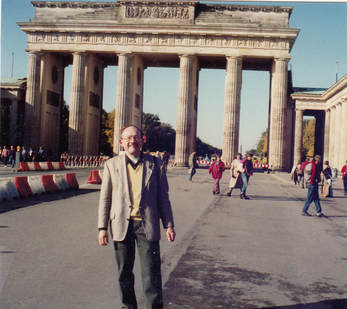 Bruce & Brandenburg Gate, Berlin -- no Wall in front, this time
Bruce & Brandenburg Gate, Berlin -- no Wall in front, this time Now that the borders between east and west were gone, it was easier to get around the city, although some U-Bahn trains from the west still couldn't stop at stations in the east. We took some day trips out to Berlin's suburbs, including Potsdam, where the allies met at the end of the War in 1945. We stood in the very room with the same table and chairs in the Cecilienhof Palace where Stalin, Truman, and first Churchill and then Clement Attlee from Britain met. The palace had been built in an English Tudor style, but felt very Germanic. We both had the same thought at that moment: this was where the future history of the world was determined, for better or worse.
"There's one more place we have to see," Sherrill told me as we left the palace, "as long as we're in Potsdam."
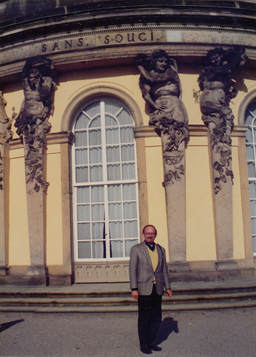 Bruce at Sans Souci, Potsdam
Bruce at Sans Souci, Potsdam Despite the elaborate rococo decorations throughout the palace, it preserved a lightness that gave it a good deal of charm. The surprises popping up in the garden, around a corner or beyond a hedge or tree, added a pleasant sense of anticipation as we strolled through it. Looking back, I can see how Sherrill was inspired by Sanssouci—as well as, of course, other places large and small that we visited over the years.
Surprises await the visitor throughout our own much smaller garden: it might be a mirror in a corner, a five foot tall giraffe behind a tree, a little pagoda under a shrub, or one of two dozen other animals scattered among the plants. The idea, she said, was to give joy, and the surprises that she tucked away in our garden did and do give joy. Her goal in the house was an uncrowded lightness with its own carefully placed details adding variety and aesthetic pleasure. Sometimes, I didn't understand what she was doing or why while she was doing it, but I learned to appreciate and admire her efforts—whatever inspired them, a magazine article, something she saw on a trip, or her own sense of whimsy.
To be continued....
 RSS Feed
RSS Feed